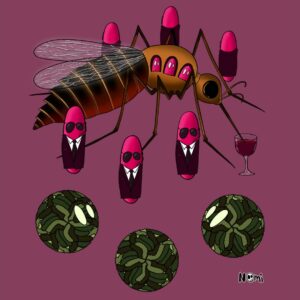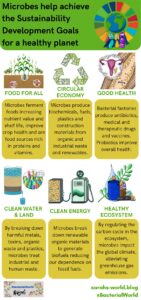You may know that microbes are helping to save the planet, but did you know they are also helping to save your meal?
Microbes are necessary for many of our favorite foods, such as bread, cheese, and chocolate, and the beverages we wash them down with, like beer and wine!
With the holidays fast approaching, let’s look at how microbes play a central role in the holiday menu.
Microbes Help Make What You Eat
Microbes are everywhere, including your food. Not only known for food spoilage, but some microbes also help preserve and add flavor to foods. In a process called microbial fermentation, microbes convert sugars in foods into different compounds, such as alcohols or acids.
Bread
Microbes are also necessary to produce our foods. Many holiday meals include special bread that depends on the microorganism yeast. Bread making usually uses the yeast Saccharomyces cerevisiae to eat the sugar in bread dough to make carbon dioxide (CO2) bubbles that expand and rise the bread.
Microbes can also give bread some of its flavors. Sourdough bread gained popularity during the COVID-19 pandemic because of the ease of culturing the sourdough yeast, called a starter. Sourdough’s unique flavor comes from the starter’s mixture of yeast and lactic acid bacteria. These Lactobacillus bacteria ferment and produce lactic acid, which gives sourdough that ‘sour’ taste and helps to prevent the bread from going stale.

Cheese
After making your holiday loaf, you will need to put something on those slices. Cheese is one of my favorite bread sidekicks and appears on many holiday menus.
Like bread, cheese requires a starter culture of bacteria to convert the sugars in the milk into acids such as lactic acid. Next, during cheese ‘ripening,’ added secondary microbial cultures give each cheese its unique flavor and texture. These secondary cultures can include bacteria, yeast, or even mold, like in the case of blue cheese, and all help produce those much-loved flavors.
Microbes Help Make What You Drink
Bread and cheese are delicious, but they are even better when paired with a nice beverage. Luckily, microbes help make some delicious drinks as well.
Beer
One of the oldest microbially-made drinks is beer. Beer dates back over 5,000 years, though recent evidence suggests people first fermented beer over 13,000 years ago! Like today’s beer, ancient cultures ground grains in large vats and exposed them to yeast that would eat the sugars and ferment it into alcohol and CO2.
This process adds flavor to the drink as well as many nutrients and essential B vitamins. Most importantly, the alcohol kills possible contaminates and makes the water safe to consume. Adding hops aids its antimicrobial activity by inhibiting Gram-positive bacteria.
While the first beers relied on wild yeast strains naturally found in the air and dust, today’s brewers add specific strains of yeast for desired alcohol and flavor profiles. Or they might add bacteria. Many Belgian ales have Brettanomyces yeasts to produce their notable sour flavor, while German Berliner Weisse beers are fermented by Saccharomyces cerevisiae and Lactobacillus bacteria.
Wine
If beer is not your thing, possibly you will want a nice glass of wine this holiday season. You can thank microbes for that too.
Wine is produced when yeast ferment grapes, yielding both alcohol and CO2 like for beer. Microbes are important not only for fermenting grapes, but specific yeast, fungi, and bacteria are important for keeping grapes healthy.
Additionally, some fungi are critical to produce specific wines. Botrytis cinerea is a fungus that helps to dry out and concentrate the sugars of a grape through a so-called ‘noble rot’. These grapes produce a sweet dessert wine called a botrytized wine. However, if Botrytis cinerea infects grapes during moist conditions, this ‘gray rot’ destroys the grape crop. Thus, having the right microbiome is important for agriculture just as it is for humans.
Kombucha
If you don’t like beer or wine, you can always try kombucha. This non-alcoholic beverage is produced from acetic acid bacteria and yeasts called a “tea fungus” that ferment tea. The bacteria and yeasts live symbiotically in a biofilm clump called a scoby (“symbiotic culture of bacteria and yeast”). Here, microbes work together to convert the sugars into acids that give the tea a nice tart flavor.

And don’t forget dessert!
Cakes, candies, and cookies are all staples of the holidays. These sweet treats would not be the same without microbes to add flavor and rise.
My favorite sweet, chocolate, comes from cacao beans that are initially fermented for many days by wild yeasts and bacteria. This process breaks down the beans and leads to the production of those oh so yummy chocolate flavors. Just another reason to love microbes!

Welcome Microbes to Your Next Meal
Microbes are vital for giving us so many of the foods and flavors we love. From foods like bread, cheese, and chocolate or drinks like beer, wine or kombucha, microbial fermentation plays an important role in many of our favorite dishes. Fermented foods give us flavors, vitamins, and additional food preservation.

These foods can also help maintain healthy digestive systems. Yoghurt, which is another fermented milk product, contains beneficial bacteria that can help maintain a balanced microbiome.
Not only do microbes help save the planet, but they also save our meals and our health too. So this holiday season, remember to incorporate microbial dishes into your menu.












